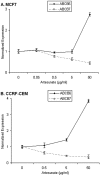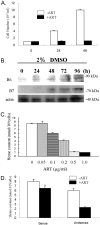Role of transferrin receptor and the ABC transporters ABCB6 and ABCB7 for resistance and differentiation of tumor cells towards artesunate
- PMID: 17726528
- PMCID: PMC1949049
- DOI: 10.1371/journal.pone.0000798
Role of transferrin receptor and the ABC transporters ABCB6 and ABCB7 for resistance and differentiation of tumor cells towards artesunate
Abstract
The anti-malarial artesunate also exerts profound anti-cancer activity. The susceptibility of tumor cells to artesunate can be enhanced by ferrous iron. The transferrin receptor (TfR) is involved in iron uptake by internalization of transferrin and is over-expressed in rapidly growing tumors. The ATP-binding cassette (ABC) transporters ABCB6 and ABCB7 are also involved in iron homeostasis. To investigate whether these proteins play a role for sensitivity towards artesunate, Oncotest's 36 cell line panel was treated with artesunate or artesunate plus iron(II) glycine sulfate (Ferrosanol). The majority of cell lines showed increased inhibition rates, for the combination of artesunate plus iron(II) glycine sulfate compared to artesunate alone. However, in 11 out of the 36 cell lines the combination treatment was not superior. Cell lines with high TfR expression significantly correlated with high degrees of modulation indicating that high TfR expressing tumor cells would be more efficiently inhibited by this combination treatment than low TfR expressing ones. Furthermore, we found a significant relationship between cellular response to artesunate and TfR expression in 55 cell lines of the National Cancer Institute (NCI), USA. A significant correlation was also found for ABCB6, but not for ABCB7 in the NCI panel. Artesunate treatment of human CCRF-CEM leukemia and MCF7 breast cancer cells induced ABCB6 expression but repressed ABCB7 expression. Finally, artesunate inhibited proliferation and differentiation of mouse erythroleukemia (MEL) cells. Down-regulation of ABCB6 by antisense oligonucleotides inhibited differentiation of MEL cells indicating that artesunate and ABCB6 may cooperate. In conclusion, our results indicate that ferrous iron improves the activity of artesunate in some but not all tumor cell lines. Several factors involved in iron homeostasis such as TfR and ABCB6 may contribute to this effect.
Conflict of interest statement
Figures


Similar articles
-
Enhancement of cytotoxicity of artemisinins toward cancer cells by ferrous iron.Free Radic Biol Med. 2004 Oct 1;37(7):998-1009. doi: 10.1016/j.freeradbiomed.2004.06.023. Free Radic Biol Med. 2004. PMID: 15336316
-
Expression of ABCB6 is related to resistance to 5-FU, SN-38 and vincristine.Anticancer Res. 2014 Sep;34(9):4767-73. Anticancer Res. 2014. PMID: 25202056
-
The effects of artesunate on the expression of EGFR and ABCG2 in A549 human lung cancer cells and a xenograft model.Molecules. 2011 Dec 19;16(12):10556-69. doi: 10.3390/molecules161210556. Molecules. 2011. PMID: 22183882 Free PMC article.
-
Mitochondrial ABC proteins in health and disease.Biochim Biophys Acta. 2009 Jun;1787(6):681-90. doi: 10.1016/j.bbabio.2009.02.009. Epub 2009 Feb 24. Biochim Biophys Acta. 2009. PMID: 19248758 Review.
-
The transferrin receptor part I: Biology and targeting with cytotoxic antibodies for the treatment of cancer.Clin Immunol. 2006 Nov;121(2):144-58. doi: 10.1016/j.clim.2006.06.010. Epub 2006 Aug 10. Clin Immunol. 2006. PMID: 16904380 Review.
Cited by
-
Treatment of Multidrug-Resistant Leukemia Cells by Novel Artemisinin-, Egonol-, and Thymoquinone-Derived Hybrid Compounds.Molecules. 2018 Apr 6;23(4):841. doi: 10.3390/molecules23040841. Molecules. 2018. PMID: 29642419 Free PMC article.
-
Artemisinin derivatives induce oxidative stress leading to DNA damage and caspase-mediated apoptosis in Theileria annulata-transformed cells.Cell Commun Signal. 2023 Apr 17;21(1):78. doi: 10.1186/s12964-023-01067-7. Cell Commun Signal. 2023. PMID: 37069625 Free PMC article.
-
Transcriptome analysis of genes associated with breast cancer cell motility in response to Artemisinin treatment.BMC Cancer. 2017 Dec 15;17(1):858. doi: 10.1186/s12885-017-3863-7. BMC Cancer. 2017. PMID: 29246124 Free PMC article.
-
ABCB6 is dispensable for erythropoiesis and specifies the new blood group system Langereis.Nat Genet. 2012 Jan 15;44(2):170-3. doi: 10.1038/ng.1069. Nat Genet. 2012. PMID: 22246506 Free PMC article.
-
Dihydroartemisinin induces autophagy and inhibits the growth of iron-loaded human myeloid leukemia K562 cells via ROS toxicity.FEBS Open Bio. 2012 May 23;2:103-12. doi: 10.1016/j.fob.2012.05.002. Print 2012. FEBS Open Bio. 2012. PMID: 23650588 Free PMC article.
References
-
- Klayman DL. Qinghaosu (artemisinin): an antimalarial drug from China. Science. 1985;228:1049–1055. - PubMed
-
- Ashley EA, White NJ. Artemisinin-based combinations. Curr Opin Infect Dis. 2007;18:531–536. - PubMed
-
- Efferth T. Willmar Schwabe Award 2006: antiplasmodial and antitumor activity of artemisinin–from bench to bedside. Planta Med. 2007;73:299–309. - PubMed
-
- Woerdenbag HJ, Moskal TA, Pras N, et al. Cytotoxicity of artemisinin-related endoperoxides to Ehrlich ascites tumor cells. J Nat Prod. 1993;56:849–856. - PubMed
MeSH terms
Substances
LinkOut - more resources
Full Text Sources

